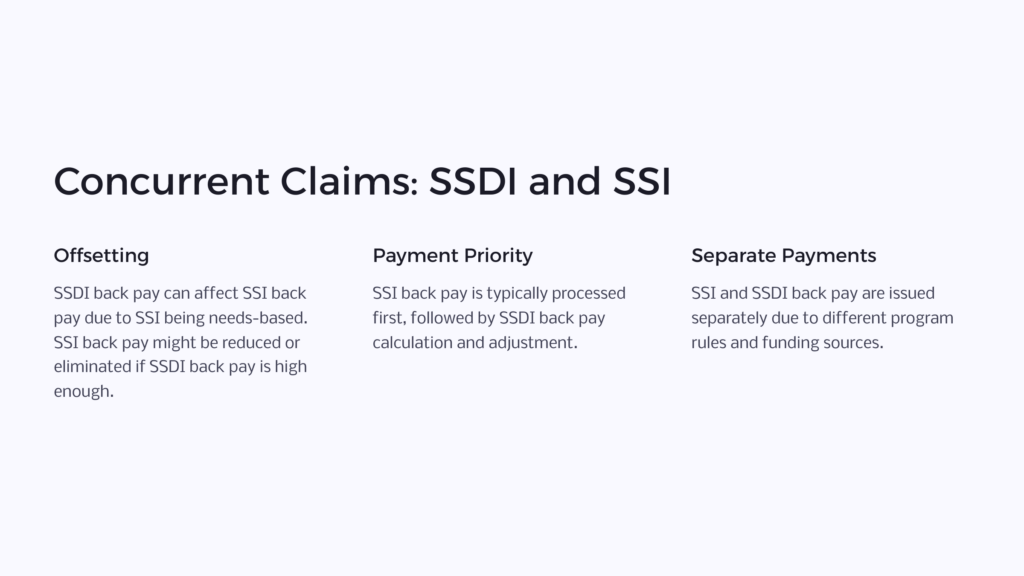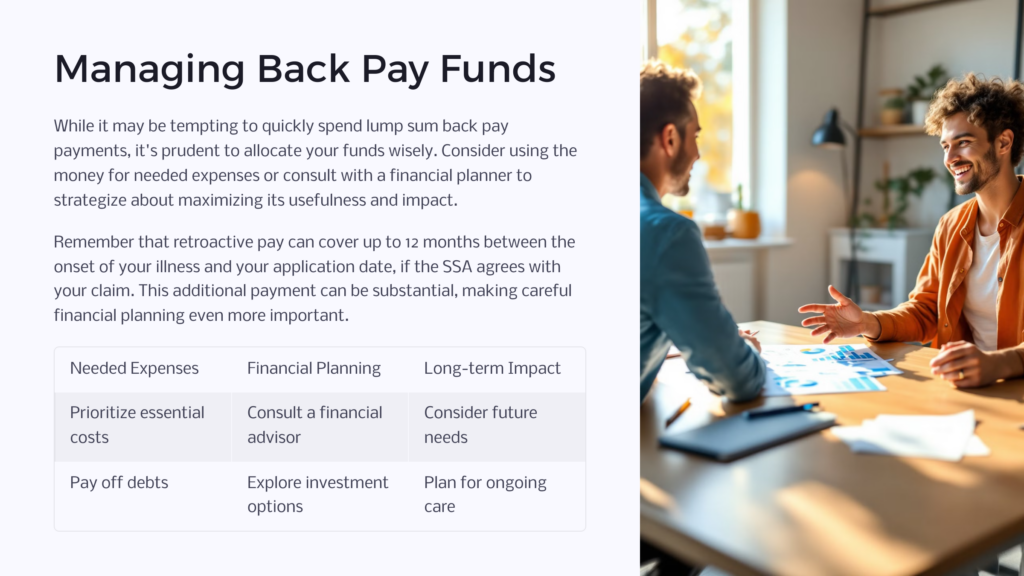When you apply for Social Security Disability Insurance (SSDI) and/or Supplemental Security Income (SSI), it will take between 8-10 months for your SSDI/SSI application to be reviewed—and sometimes longer. Thankfully, the Social Security Administration will issue SSDI/SSI back pay. You may be entitled to benefit payments that you would have received either from the date of your application or possibly earlier which will be discussed in this article.
SSDI Back Pay (Title 2)
Social Security Disability Insurance (SSDI) back pay is calculated based on the date you are determined to have become disabled, known as the “established onset date” (EOD), and the date you filed your disability claim. Here’s a step-by-step breakdown of how SSDI back pay is calculated:

- Established Onset Date (EOD): This is the date the Social Security Administration (SSA) determines you became disabled. It could be the date you alleged in your application or another date based on the medical evidence.
- Date of Filing: This is the date you submitted your application for SSDI benefits.
- Five-Month Waiting Period: There is a mandatory five-month waiting period from the EOD before SSDI benefits start. You will not receive benefits for these five months even when you have been found disabled.
- Back Pay Period: This period starts after the five-month waiting period and extends to the date your SSDI application is approved. The back pay period can go up to 12 months before the date of your application if you were disabled during that time and meet the SSDI criteria.
Here’s how to calculate it:
- Determine EOD: Identify the date SSA has established as the onset date of your disability.
- Subtract the Five-Month Waiting Period: Starting from your EOD, subtract five full months.
- Identify the Back Pay Period: Calculate the time between the end of the five-month waiting period and the date your claim was approved, or up to 12 months before your application date if applicable.
Example Calculation
- EOD: January 1, 2021
- Date of Filing: January 1, 2022
- Approval Date: July 1, 2023
- Subtract Five Months from EOD: January 1, 2021 minus five months = June 1, 2021.
- Determine Back Pay Period: From June 1, 2021 (end of waiting period) to January 1, 2022 (filing date) is 7 months. Then from January 1, 2022 (filing date) to July 1, 2023 (approval date) is another 18 months.
- Calculate Total Back Pay: Total back pay is for 7 months (before filing) plus 18 months (after filing), totaling 25 months of back pay.
Important Points
- Retroactive Pay: SSDI can pay retroactive benefits for up to 12 months before the application date if you were eligible during that time.
- Monthly Benefit Amount: The monthly amount is determined based on your average lifetime earnings. Each individual’s monthly benefit amount will be different and unique to them.
This calculation can get complex, especially with factors like the precise onset date and any additional earnings during the period. Consulting with a Social Security attorney or representative can help ensure accurate calculations and maximize your benefits.
SSI Back Pay (Title 16)
Supplemental Security Income (SSI) back pay is determined based on several factors, including the date you first applied for SSI benefits and the date you were found eligible. Here’s a step-by-step overview of how it works:
- Application Date: The date you filed your SSI application is critical because SSI back pay can only be paid from the first full month after you applied.
- Eligibility Date: The Social Security Administration (SSA) will determine the date you became eligible for SSI benefits based on the onset of your disability or the date you met all the other eligibility requirements.
- Monthly Benefits Calculation: Your monthly SSI benefit amount is calculated based on your income and living situation. The maximum federal benefit rate in 2024 is $943 per month for an individual and $1,415 for a couple, though this amount can be reduced if you have other income or receive in-kind support and maintenance.
- Retroactive Payments: SSI back pay is generally paid for the period between the date you applied (or the date you became eligible, if later) and the date your benefits start. This can result in several months of back pay, depending on how long it took to process your application.
- Payment Method: SSI back pay is usually paid in three installments if the amount exceeds three times the maximum monthly benefit. The first two installments are capped at three times the maximum monthly benefit, and the final installment includes any remaining back pay.
- State Supplements: Some states provide additional SSI payments, which can affect the total amount of back pay you receive.
- Other Considerations: If you received interim assistance from the state while your SSI application was pending, the state might be reimbursed from your back pay.
To summarize, SSI back pay is calculated based on your application date, the date you were determined eligible, and your monthly benefit amount, with consideration for any state supplements and interim assistance.
Concurrent Claims

If you qualify for both SSI and SSDI (a concurrent claim), the coordination of back pay can get more complicated:
- Offsetting: SSI is needs-based, so your SSDI back pay might affect your SSI back pay. If you receive SSDI back pay, it can reduce the amount of SSI back pay you’re eligible for because it counts as income. This means the SSI back pay might be recalculated and reduced or potentially eliminated if the SSDI back pay is high enough.
- Payment Priority: Typically, SSI back pay is processed first because SSI is a means-tested program. After the SSI back pay is issued, the SSDI back pay is calculated and adjusted accordingly.
- Interim Benefits: If you receive SSI while waiting for SSDI approval, the Social Security Administration (SSA) may consider those SSI payments as an advance against your SSDI back pay. Once your SSDI is approved, the SSA may require you to repay the interim SSI benefits out of your SSDI back pay.
- Separate Payments: Though processed together, SSI and SSDI back pay are issued separately because they come from different programs with distinct rules and funding sources.
Steps to Manage Back Pay
- Monitor Communications: Keep track of all correspondence from the SSA, as they will provide detailed information on how your back pay is calculated and when it will be issued.
- Understand Impact on Benefits: Be aware of how receiving back pay might affect other benefits you receive, such as Medicaid, housing assistance, or food stamps.
- Seek Professional Advice: Consider consulting with a disability attorney or advocate who can help navigate the complexities of your concurrent claim and ensure you receive the correct amount of back pay.
If you have specific circumstances or need detailed calculations, it might be beneficial to get personalized advice from a professional familiar with disability benefits.

Social Security Back Pay

When applying for SSDI, there is a standard 5-month wait that does not count towards back pay. That’s why it is always important to file for Social Security Disability as soon as you become disabled. Do not attempt to wait out your illness or see how it develops. When you apply, make sure you provide all the necessary paperwork, meet the deadlines, and show up to your interview, in order to speed up the process.
In most cases, you will benefit from soliciting the services of a Social Security disability lawyer to help you file a case.
Retroactive pay covers any time period (up to 12 months) between the onset of your illness and when you filed your application, if the SSA agrees with your claim in such matters. It may be tempting to quickly spend lump sum payments, but it’s prudent to allocate your funds wisely to needed expenses or strategize with a financial planner about how to maximize their usefulness and impact.
 Benefits.com Advisors
Benefits.com Advisors
With expertise spanning local, state, and federal benefit programs, our team is dedicated to guiding individuals towards the perfect program tailored to their unique circumstances.
Rise to the top with Peak Benefits!
Join our Peak Benefits Newsletter for the latest news, resources, and offers on all things government benefits.





















